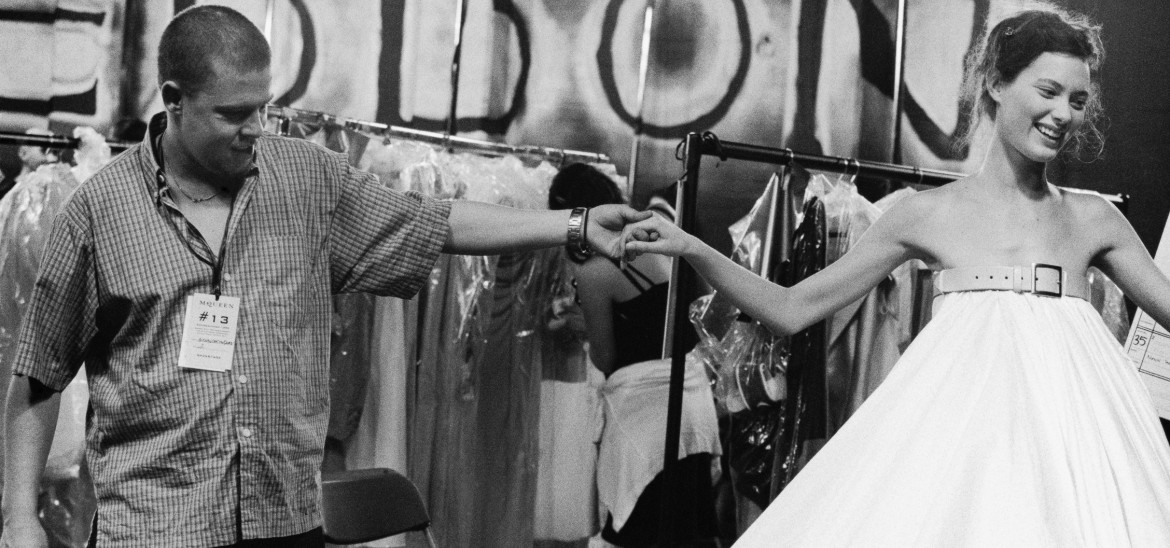Into Film Clubs
Find out everything you need to know about starting an Into Film Club.



McQueen is a compelling documentary about British fashion designer Alexander ‘Lee' McQueen. Raised in a working class London environment, McQueen served an apprenticeship on Saville Row, before dazzling the fashion industry with a ground breaking graduation show from St Martin's College. From there his rise was meteoric, and he became one of the most well-known and influential names in fashion, as his work continued to astound with its innovation.
But Lee also had his demons, and his life was tragically cut short in 2010 when he took his own life, just one day before the funeral of his beloved mother. Directed by Ian Bonhôte and Peter Ettedgui, McQueen combines interviews of his friends and family with archival footage of the man himself to tell his remarkable story, and highlight wider issues in culture, fame, creativity, wellbeing and mental health.
The fashion world is associated with high glamour, captured in films such as The Devil Wears Prada, Coco Before Chanel and The September Issue, but Lee came from a very ordinary, working-class background,; his father a cab driver and his mother a teacher. In an environment beset by class prejudice, McQueen had to rely on his talent and infectious personality to secure opportunities that might otherwise have been denied to him. Out of work, with few academic qualifications, he was forced to use his dole money to buy fabric for his clothes. After his name was established in the 1990s, he became associated with a remarkable period in which youthful British culture (known as "cool Britannia") was positioned as the disruptive centre of the creative world: in music through Britpop; in film with directors such as Danny Boyle; through contemporary artists like Tracy Emin, Steve McQueen (no relation) and Damien Hirst; and in fashion through Lee and Stella McCartney.
One of the inspiring aspects of McQueen's work was his ability to fashion beautiful products out of seemingly anything, such as cling film, or a rubber tyre - a resourceful approach to creativity that could be applied to any art form when working with the low budgets. As well as the striking designs and exquisite cut of the clothes themselves, McQueen's shows were extraordinary visual installations that drew attention to topics rarely discussed at the time, such as artificial intelligence, mental health, and sexual harassment. This made his art hugely provocative and controversial at the time. He also challenged the conventions of catwalk modelling and body image by using plus-sized women and people with physical disabilities in his shows.
There was a darkness to his work, with collections being influenced by sinister stories such as Jack the Ripper and Patrick Süskind's novel Perfume: The Story of a Murderer. McQueen used his fashion shows as a storytelling device: political theatre, as much as haute couture. As well as this, Lee developed a close working relationship with composer Michael Nyman, responsible for some of the most beautiful film scores of recent years, including The Piano and Gattaca, as well as McQueen itself.
However, such pioneering work brought pressures. As his name became known around the world, McQueen felt a constant need to push himself and go further and further, taking on increasingly unrealistic levels of work and living in fear of going stale. Lee was now a global celebrity, but he was uncomfortable with fame. Whilst he was happy to have attention lavished on his work, he did not like the camera being turned on himself. This is reflected in the film through the absence of celebrity talking head interviews, focusing instead on those closest to him. His attitude to fame is similar to the late fashion photographer Bill Cunningham, whose work was celebrated in wonderful 2010 documentary Bill Cunningham: New York.
This pressure took an increasing toll on McQueen's wellbeing. He struggled for many years with his body image, with his weight fluctuating alarmingly in later years. There were also acute battles with mental health, partly stemming from a childhood where he was abused, and a frequent witness to scenes of domestic violence. Work pressures and an increasing drug addiction brought about an alarming paranoia in his personality, as well as an agonising depression. As the film movingly captures, his struggles impacted not only on him, but also the people he loved the most. Like many artists, Lee was for a long time able to channel this darkness into his work: both through the themes of what he was producing, and also via the therapeutic act of creativity itself - in his case sewing. Tragically, this was not enough.
Stories such as McQueen's can encourage young people from lower income backgrounds to pursue their creative dreams and highlights that class should not be a barrier to artistic opportunity. They also encourage us to think differently about art and creativity, demonstrating that a lack of resources need not be a barrier. Documentaries about the tragic downfall of iconic celebrities have become common in recent years, with Amy, Cobain: Montage of Heck and the forthcoming Whitney all contributing to the trend. They point to the enduring fascination these figures have within our culture, but also serve as cautious warnings to us all around our own attitudes to fame. They rightly celebrate the enduring legacy of these artists, and remind us why they were such forces of nature, but also caution us that wealth and fame do not bring happiness. Most importantly, they help to start a conversation around looking after ourselves and other people better, and the importance of communication when faced with mental and emotional difficulties.
Viewing 4 of 4 related items.

Find out more about our streaming service, designed specifically for UK schools.